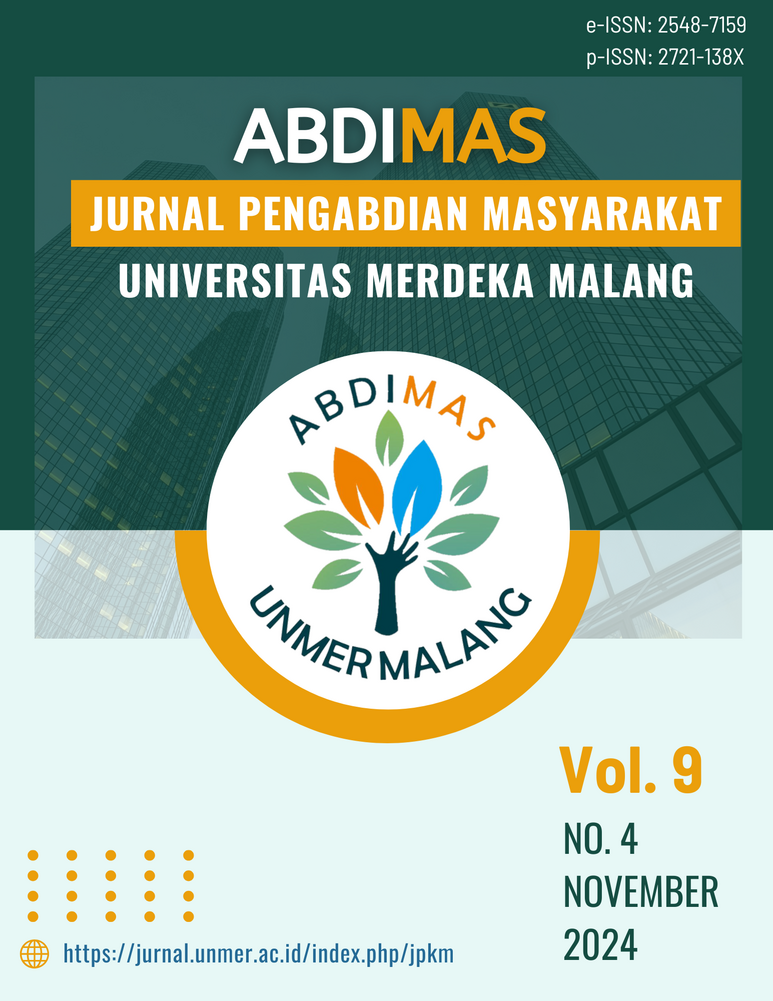Arjasa Village farmer assistance in cassava peel and Trichoderma fungus processing as organic fertilizer
DOI:
https://doi.org/10.26905/abdimas.v9i4.14239Keywords:
Cassava peel, Farmer groups, FertilizerAbstract
The Sumber Tani Farmer Group in Arjasa Village faces limited subsidized fertilizer for tobacco and corn cultivation. Meanwhile, in Arjasa Village there are cassava processing MSMEs, but cassava peel waste is only left to accumulate to rot and even thrown into the river. Therefore, the purpose of this assistance is to overcome the problems of farmer groups through the use of cassava peel waste and a combination of Trichoderma fungi as an alternative to urea fertilizer. This research method includes making fertilizer, mushroom propagation, socialization and training, testing the fertilizer content, and applying it to plants. Laboratory test results show the composition of Savaderma fertilizer is 36.70 percent moisture content; 1.33 percent nitrogen; 0.11 percent phosphorus; and 0.53 percent potassium. Savaderma fertilizer application on tobacco plants showed an increase in plant resistance to pest attacks compared to untreated plants. This research proves the potential of cassava peel waste and Trichoderma fungus as an alternative environmentally friendly fertilizer.
Downloads
References
Abidin, Z., & Rohman, M. (2020). Pemberdayaan kelompok tani dalam pembuatan pupuk organik berbahan baku limbah rumah tangga. Community Development Journal: Jurnal Pengabdian Masyarakat, 1(2), 89-94. https://doi.org/10.31004/cdj.v1i2.709
Amilia, W., Rusdianto, A. S., & Choiron, M. (2024). Empowerment of the Tirtobakti II farmer group to improve production capacity of frass organic fertilizer. Abdimas: Jurnal Pengabdian Masyarakat Universitas Merdeka Malang, 9(2), 338-349. https://doi.org/10.26905/abdimas.v9i2.12423
Derianto, A., Lestari, F., Nur, M., & Hartati, M. (2021). Analisis tekno ekonomi pemanfaatan limbah cair tahu menjadi pupuk cair dengan metode eksperimen (Studi Kasus: CV. Tahu Boga Sari). Jurnal Sains, Teknologi dan Industri, 18(02), 274-282.
Kautsar, M. R., Sofyan, S., & Makmur, T. (2020). Analisis kelangkaan pupuk bersubsidi dan pengaruhnya terhadap produktivitas padi (Oryza sativa) di Kecamatan Montasik Kabupaten Aceh Besar. Jurnal Ilmiah Mahasiswa Pertanian, 5(1), 97-107.
Kementerian Perdagangan Republik Indonesia. (2013). Peraturan Menteri Perdagangan Nomor 15/M-DAG/PER/4/2013 tentang Pengadaan dan Penyaluran Bahan Bakar Minyak. Kementerian Perdagangan Republik Indonesia.
Migusnawati, M., Amelia, K., & Sari, W. (2022). Aplikasi pupuk organik kulit singkong guna peningkatan pertumbuhan dan produksi tanaman jagung (Zea mays L). Journal of Scientech Research and Development, 4(1), 016-022. https://doi.org/10.56670/jsrd.v4i1.40
Novianti, D. (2018). Perbanyakan Jamur Trichoderma Sp pada beberapa media. Sainmatika: Jurnal Ilmiah Matematika dan Ilmu Pengetahuan Alam, 15(1), 35-41. https://doi.org/10.31851/sainmatika.v15i1.1763
Nuraeni, A., Khairani, L., & Susilawati, I. (2019). Pengaruh tingkat pemberian pupuk nitrogen terhadap kandungan air dan serat kasar Corchorus aestuans. Pastura, 9(1), 32-35. http://dx.doi.org/10.24843/Pastura.2019.v09.i01.p09
Putra, B. W. R. I. H., & Ratnawati, R. (2019). Pembuatan pupuk organik cair dari limbah buah dengan penambahan bioaktivator EM4. Jurnal Sains & Teknologi Lingkungan, 11(1), 44-56. https://doi.org/10.20885/jstl.vol11.iss1.art4
Rosiman, R., Sumadi, S., & Rachmadi, M. (2020). Pengaruh kombinasi jamur Trichoderma harzianum dan bokashi terhadap pertumbuhan tiga kultivar kedelai. Jurnal Kultivasi, 19(2), 1142-1149. https://doi.org/10.24198/kultivasi.v19i2.26469
Suanda, I. W., Budiasa, I. M., Suta, I. N., Ariati, P. E. P., Widnyana, I. K., & Suparyana, P. K. (2021). Pemberdayaan kelompok tani melalui pelatihan pestisida nabati dan pupuk organik di Dusun Kembang Sari, Desa Tukadaya, Kecamatan Melaya, Jembrana Bali. Jurnal Aplikasi dan Inovasi Iptek, 2(2), 131-139. https://doi.org/10.52232/jasintek.v2i2.67
Sujatna, I., Muchtar, R., & Banu, L. S. (2017). Pengaruh trichokompos terhadap pertumbuhan dan hasil tanaman seledri (Apium greveolens L.) pada sistem wall garden. Jurnal Ilmiah Respati, 8(2). 731-738. https://doi.org/10.52643/jir.v8i2.78
Sulistyowati, L., Pangaribuan, N., Olive, O., Ratnawati, T., & Rachman, A. (2022). Pemanfaatan pupuk organik kulit singkong untuk budidaya tanaman pangan dengan pola tumpang sari di Kelurahan Ciluar Kota Bogor. Abdimas Galuh, 4(2), 1312-1319. http://dx.doi.org/10.25157/ag.v4i2.8536
Tehuayo, J. H. (2023). Sosialisasi dan pembuatan pupuk organik jamur Trichoderma terhadap petani di Desa Rumah Tiga. Pattimura Mengabdi: Jurnal Pengabdian Kepada Masyarakat, 1(4), 338-341. https://doi.org/10.30598/pattimura-mengabdi.1.4.338-341
Utami, M. A., Nasution, R. A., Mawaddah, F. A., & Aulia, R. (2024). Pengendalian jamur ganoderma dengan metode perbanyakan jamur trichoderma pada pembibitan kelapa sawit di PT PP London Sumatra Bah Lias Research Station. El-Mujtama: Jurnal Pengabdian Masyarakat, 4(1), 243-248. https://doi.org/10.47467/elmujtama.v4i1.3297
Yuhanna, W. L., Nurhikmawati, A. R., Pujiati, P., & Dewi, N. K. (2021). Pemberdayaan masyarakat Desa Wakah melalui pemanfaatan limbah kulit singkong (Manihot esculenta). Aksiologiya: Jurnal Pengabdian Kepada Masyarakat, 5(3), 411-419. https://doi.org/10.30651/aks.v5i3.4897
Yusmayani, M. (2019). Analisis kadar nitrogen pada pupuk urea, pupuk cair dan pupuk kompos dengan Metode Kjeldahl. Amina, 1(1), 28-34. https://doi.org/10.22373/amina.v1i1.11
Downloads
Published
How to Cite
Issue
Section
License
Copyright (c) 2024 Abdimas: Jurnal Pengabdian Masyarakat Universitas Merdeka Malang

This work is licensed under a Creative Commons Attribution-ShareAlike 4.0 International License.
Authors who publish with this journal agree to the following terms:
- Copyright of the published articles will be transferred to the journal as the publisher of the manuscripts. Therefore, the author confirms that the copyright has been managed by the journal.
- Publisher of Abdimas: Jurnal Pengabdian Masyarakat Universitas Merdeka Malang is University of Merdeka Malang.
- The copyright follows Creative Commons Attribution-ShareAlike License (CC BY SA): This license allows to share, copy, and redistribute the material in any medium or format, adapt, remix, transform, and build upon the material, for any purpose, even commercially.





